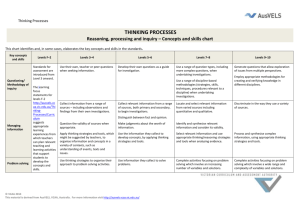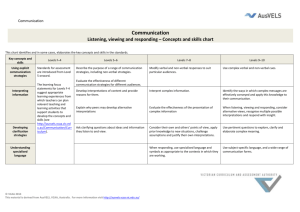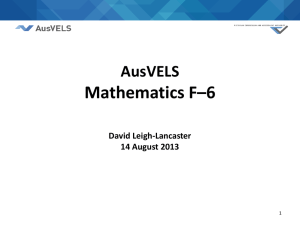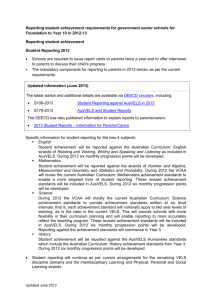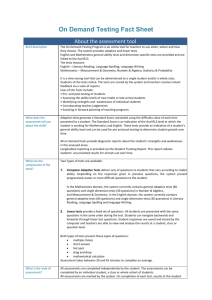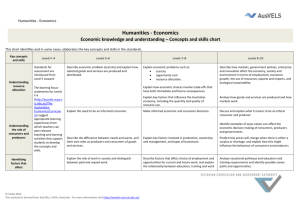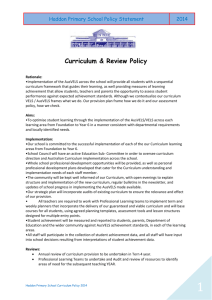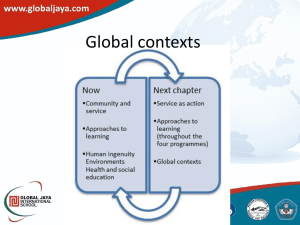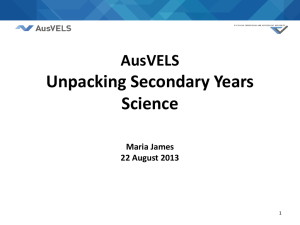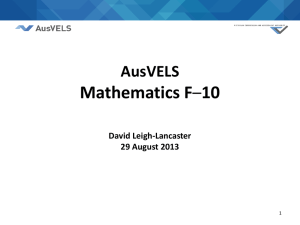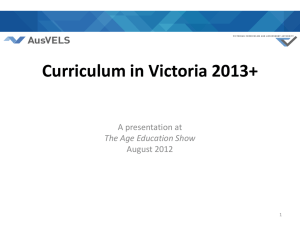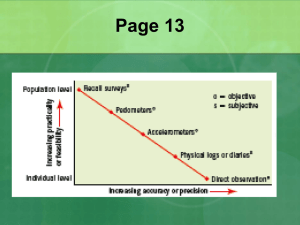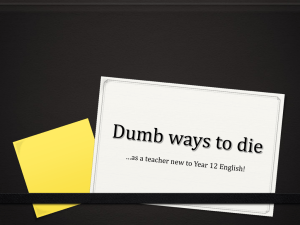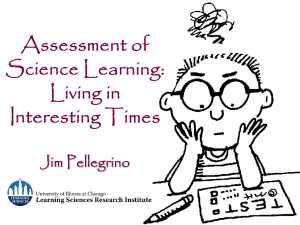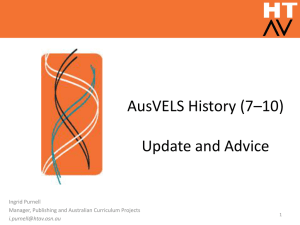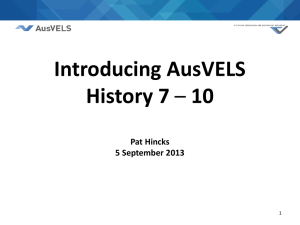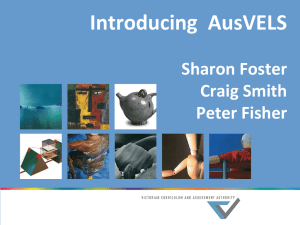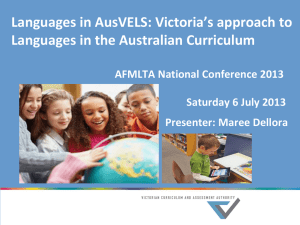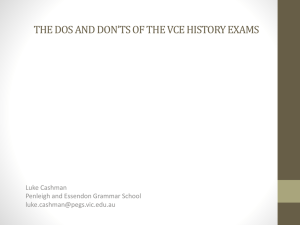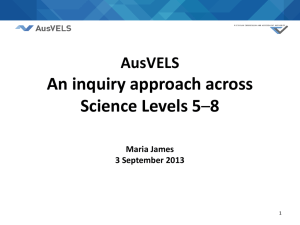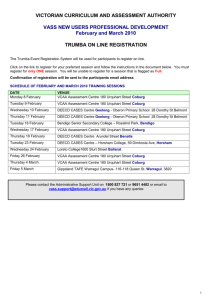to access this presentation.
advertisement
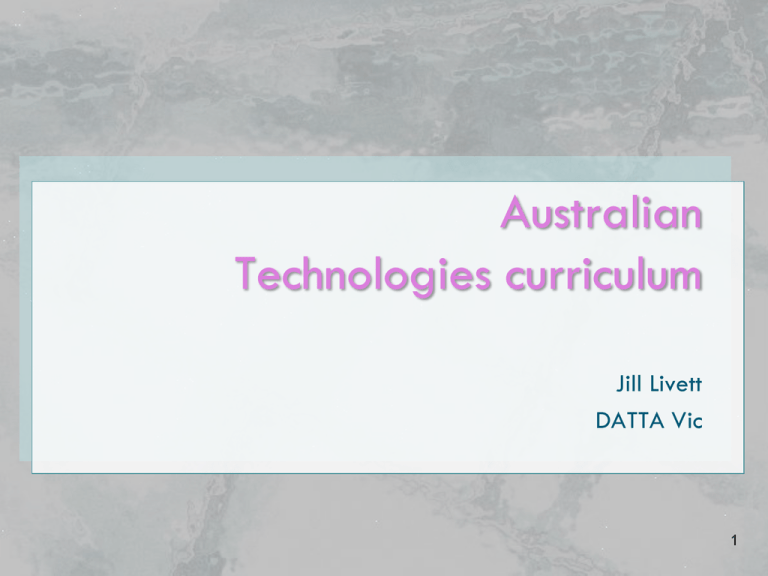
Australian Technologies curriculum Jill Livett DATTA Vic 1 the basics The Australian Curriculum: • is required to be taught within all schools in Victoria – Government and Catholic schools have agreed to, and are required to implement through AusVELS – Independent schools can choose to implement through AusVELS, or directly access the Australian Curriculum through the ACARA documentation, or offer an equivalent registered curriculum (e.g. IB) • has learning areas (roughly equivalent to VELS domains) • is mainly focussed on Foundation to Year 10 (some areas developed for senior secondary) 2 the basics • the learning areas have been written and implemented during different phases – Phase one (implemented 2013) • English, Maths, Science, History (part of Humanities and Social Sciences: HSS) – Phase Two (implemented 2015, fully reported to by 2017) • The Arts, Geography (HSS) – Phase Three (implemented 2015 onwards, reported to by 2017) • Technologies, Health and Physical Education, Languages, Civics and Citizenship (HSS), Economics and Business (HSS), Work Studies (Years 9-10) 3 the basics Other curriculum areas to be incorporated into all learning areas • General capabilities – literacy, numeracy, ICT, creative and critical thinking, personal and social capability, ethical understanding, intercultural understanding (AusVELS) • Cross Curriculum Capabilities – Studies of Aboriginal and Torres Straits Islander Histories and Culture – Asia and Australia’s engagement with Asia – Sustainability 4 current state of play • Australian Curriculum Review – Commissioned by Federal Education Minister Pyne – Review released in October – Recommendations that affect D&T • That the Technologies learning area be introduced from Year 9 (or from Year 7 in some sections of the report) • That the 2 strands (Knowledge and understanding, and processes and production skills) be integrated – The Ministers of Education at a meeting in Dec 2014, referred the review findings on to ACARA for progress – Currently, the Victorian position is that we will continuing implementing in accordance with the VCAA Curriculum Planning Guidelines (Technologies drawn on F-2, reported on 3-8, elective 9-10) 5 Technologies aims Technologies aims to develop the knowledge, understanding and skills to ensure that, individually and collaboratively, students: • investigate, design, plan, manage, produce and evaluate technologies solutions (what does this sound like?) • are creative, innovative and enterprising when using traditional, contemporary and emerging technologies, and understand how technologies have developed over time • make informed and ethical decisions about the role, impact and use of technologies in society and for a sustainable future • engage confidently with and responsibly select and manipulate appropriate technologies — resources, materials, data, systems, tools and equipment — when designing and creating solutions • critique and evaluate problems, needs or opportunities to identify and create solutions ACARA Technologies Curriculum (Feb 2014, published, not yet endorsed) 6 Design and Technologies aims • develop confidence as critical users of technologies, and designers and producers of designed solutions • investigate, generate and critique innovative and ethical designed solutions for sustainable futures • use design and systems thinking to generate design ideas and communicate these to a range of audiences • produce designed solutions suitable for a range of technologies contexts by selecting and manipulating a range of materials, systems, components, tools and equipment creatively, competently and safely; and managing processes • evaluate processes and designed solutions and transfer knowledge and skills to new situations • understand the roles and responsibilities of people in design and technologies occupations and how they contribute to society 7 technologies - key ideas • Preferred futures – students critique, design and make solutions that create the sort of future that is beneficial for all • Project management – developing students’ ability to plan and manage their project work effectively – logical planning, use of time, equipment, and materials 8 technologies - thinking • Systems thinking – an holistic approach to identifying and solving a problem – looking at interactions and interrelationships, their impacts on the whole • Design thinking – using strategies to understand the design need and opportunities, generate creative and innovative ideas, planning and evaluating what best suits the need • Computational thinking – problem solving method used in digital technologies – to organise data logically, break a problem into parts, interpret patterns and models, designing and implementing algorithms 9 the Technologies learning area • is core from F-8, some flexibility at 9-10 • is divided into two subject areas – Design and Technologies – Digital Technologies 10 curriculum organisation • the Technologies curriculum is organised through: – bands that group year levels together • F-2, 3-4, 5-6, 7-8, 9-10 – Each subject has a distinctive curriculum that is organised into: • • • • strands content descriptions elaborations (suggestions) achievement standards 11 Technologies strands Design and Technologies Digital Technologies Knowledge and understanding Knowledge and understanding Technologies and society • the use, development and impact of technologies in people’s lives Technologies contexts • technologies and design across a range of technologies contexts Digital systems • the components of digital systems: hardware, software and networks and their use Representation of data • how data are represented and structured symbolically Processes and production skills Processes and production skills Creating designed solutions by: • investigating • generating • producing • evaluating • collaborating and managing Collecting, managing and analysing data Creating digital solutions by: • defining • designing • implementing • evaluating • collaborating and managing 12 contexts in the D&T subject, there are four contexts (specialisation areas) • Engineering Principles and Systems • Food and Fibre Production • Food Specialisation • Materials and Technologies Specialisations At each band level from F-8, all students are required to undertake learning in all contexts *In F-2, Food and Fibre Production and Food Specialisation are combined 13 contexts Engineering Principles and Systems • similar to the VELS Systems Technology • related to forces that are used to create light, sound, heat, movements, control or support in systems. 14 contexts Food and fibre production • covers the development and production of primary resources – agriculture, horticulture, aquaculture, forestry, etc. Image courtesy of hin255 at FreeDigitalImages.net 15 contexts Food specialisation • exploring the characteristics and properties of food and their importance in maintaining health – involves designing/ developing and making food products and services 16 contexts Materials and Technologies specialisations • exploring the characteristics and properties of materials – including wood, metal, plastics, textiles, paper, cardboard, composites, smart materials. – In later years, this context can also cover specific specialisations, including VCD, architecture, fashion, electronics, etc. 17 designed solutions All students need to create a range of designed solutions during each band. At least one: • product • environment • service 18 designed solutions a product • a physical or tangible result of a design process that meets a need (e.g. chair, dress, meal, electronic circuit, an app, an advertising pamphlet, etc.) 19 designed solutions an environment • the result of a design process that is a space or place that can be natural, managed or built e.g. room interior, garden, cubby house, play area, etc. 20 Image courtesy of Simon Howden at FreeDigitalImages.net designed solutions a service • the result of a design process that is less tangible – e.g. a maintenance plan, cafe or catering service, communication service or provision, transportation service system, - usually explained through plans, flow charts, diagrams procedures, etc. 21 Image courtesy of stockimages at FreeDigitalImages.net design and technologies processes a term that is used frequently, seems to mean: • the design process (VELS) - but • plural – not one set process, but varying forms of process that are different - dependent on the situation, types of solution and level of students • covers designing, production and evaluation stages • it doesn’t mean the individual processes used in production 22 scope and sequence Reference point – available as a download • contains the strands and content descriptions for each band 23 band descriptions Contains: • the strand and content descriptions • indications of links to General Capabilities and Cross Curriculum Priorities • Elaborations – suggestions of how the content could be taught (for guidance and directions, not required) • Achievement Standards – expected student capabilities at the end of the band level (assessment?) 24 learning in design and technologies Key ideas • use of design briefs 25 learning in design and technologies Factors influencing design decisions • sustainability and ethics • function • aesthetics • enterprise and marketing • work health and safety 26 Image courtesy of bugphai at FreeDigitalImages.net learning in design and technologies Progression of production skills • producing designs and products/solutions • managing projects and collaboration 27 Victorian implementation – so far • VCAA will publish the AusVELS version of the Technologies area in Term 1, 2015 • Technologies will be core/mandatory from Year 3-8, optional/elective in Years 9-10, • Foundation-2 – it will be ‘drawn on’ to develop curriculum • Visual Communication Design – only mentioned in the Materials Specialisation of Design and Technologies of the Australian Curriculum – not in the Arts – VCAA is writing a VCD curriculum to be included in the AusVELS Arts curriculum for 7-10 28 issues Covering all contexts Covering all types of designed solutions – products, environments and services? • do we know what they are? May require targeted professional learning for teachers Covering all of the Cross Curriculum Priorities? • Sustainability is ‘natural fit’ for the Technologies area – the other two areas may be much more difficult • Shouldn’t be an ‘add on’ – should be relevant Time • division of Technologies time (into subjects and contexts) shouldn’t be ‘equal’ – some areas have much more content than others 29 resources • General – Scootle – TES - http://www.tesaustralia.com/technologies-secondary-teaching-resources/ – National STEM Centre UK http://www.nationalstemcentre.org.uk/elibrary/technology/ – Design awareness in schools http://www.vcaa.vic.edu.au/Pages/foundation10/curriculum/resources/designawar eness/index.aspx – if you need the VCAA Curriculum guidelines (official VCAA position on all things AusVELS, go to the: F-10 Curriculum Planning and Reporting Guidelines http://www.vcaa.vic.edu.au/Documents/auscurric/F10CurriculumPlanningReporting.pdf 30 resources • Sustainability – – – – www.thesecretlifeofthings.com www.ecodesigners.com.au http://practicalaction.org/schools Designing sustainable products - www.business.vic.gov.au/marketing-sales-andonline/business-sustainability/designing-sustainable-products – Fairtrade • • Asia and Australia’s engagement with Asia – suggested areas – Product design (miniturisation, small space, ethnic, fashion e.g. harajuku), food Aboriginal and Torres Straits Islander cultures and histories – textiles design, cloaks, bush mechanics, food 31
